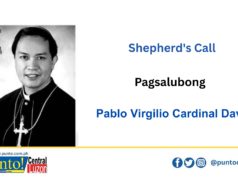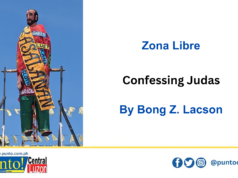Master parul maker Roland Quiambao talks of upping the ante for the local lanterns in terms of innovations to make them all-season and take their magical brilliance to the international market. Quiambao deserves all the support he can get, from government and private business, in this endeavor that surely shall assure the parul craft – and the city – a global niche.
At the rate “innovations” go in the lantern industry now though, the parul Quiambao dreams of taking to the world market may be anything but that which put the city in the Christmas map.
Year after year, a ghost of Christmas long past metaphorically goes our parul sampernandu. An elegy, if not a eulogy indeed, makes this piece published here over three years ago.
Bedazzled, bothered
IT MADE its Hollywood debut in 1993, holding its own stellar right in a Tinseltown already bedazzled by Liam Neeson in Schindler’s List, Tom Hanks and Denzel Wshington in Philadelphia, Robin Williams in Mrs. Doubtfire, and the very young.
Johnny Depp and Leonardo DiCaprio in their breakout film What’s Eating Gilbert Grape. A year earlier, it was the toast at the World Expo in Spain.
Its kaleidoscope of dancing lights and colors rousing Vivas! and Oles! from the dons and donas of the Iberian peninsula.
In Austria, it added up to the magnificence of the Stadtturm in Innsbruck; permeated the Rathausplatz Christkindlmarkt in Vienna with the Filipino spirit of Christmas; and became an object of curious wonder at the Ethnology Museum also in Vienna.
It brought Yuletide joy to the Lord Mayor’s House in Dublin, Ireland. It was the star of hope, love and joy that welcomed homesick Filipinos to the Good Shepherd Cathedral in Singapore.
It has become the seasonal motif, indeed the distinguishing seal, in Philippine embassies and consulates in Canada, Russia, Poland, Thailand, Malaysia and the United States.
In New York, it mesmerized the cosmopolitan crowd of Fifth Avenue when it was exhibited at the Philippine Center.
In San Francisco, it became one unifying factor for Fil-Ams when it was displayed at the main entrance of the St. Patrick’s Church, even as it spawned a Ligligan Parul around the SoMa area, initiated by community organizer MC Canlas, a native of San Fernando.
In 2013, it made history as the first-ever Asian (outside China) entry in the exclusivist and revered Xiamen Lantern Festival.
That same year too, it drew crowds to the 2nd Annual Parol Festival in Honolulu, Hawaii where Vice Mayor Jimmy Lazatin defined the “message of hope that the lanterns of San Fernando bring to Filipinos here and abroad” It has been all around the globe.
All around the country too, from the main avenues of Davao City to Manila’s Roxas Boulevard to the Cultural Center of the Philippines.
It has put the City of San Fernando in the world map as, in the words of CNN, “Asia’s Christmas capital.”
It is the signature craft and product of the capital city. Indeed, its officially registered OTOP (one town, one product).
As well, the core of its biggest fiesta and annual extravaganza – the Giant Lantern Festival, which was awarded as the first runnerup for Best Tourism Event in the Philippines at the recent 10th Pearl Awards in Bacolod City organized by the Association of Tourism Officers of the Philippines (ATOP) and the Department of Tourism. So much has the parul sampernando done for the city and its citizens.
But for the perfunctory paeans like this piece and the obligatory laudations from the local officials at every launch of the annual lantern festival, where has the parul sampernandu gone?
It has made its presence everywhere – around the globe, around the country – but has vanished from home altogether.
The Parul Sampernandu (as proper noun now in keeping with the event) makes its presence only in the Giant Lantern Festival.
Its smaller actual edition maybe in some little corner of a lantern craftsman’s workshop in the flood-prone areas of Barangay Del Pilar. Search all those roadside lantern stalls, whether makeshift or concrete – and despair: They have only flashing LED lights in transparent plastic cables, shaped into stars, flowers, Santa and his reindeer, Christmas trees, even helicopters.
But no parul sampernandu – as we know it: alambre frame covered with colored papel de japon or thin plastic fabric, its price dependent on the number of bulbs and the variety of “plays.”
This is a sad commentary of the times. We persist in celebrating a tradition, yet, unmindful of its dying. As we are bedazzled by the brilliance of the giant lanterns, so must be, moreso, bothered by the fast disappearance of the parul sampernandu from our city.
The annual Giant lantern Festival is not all there is to the parul sampernandu.There is the greater need of its preservation as craft, as product, for the Fernandinos. Thereby the imperative of its continuity – for generations to come – as cultural icon, as the very symbol, aye, the very soul, of the city.



